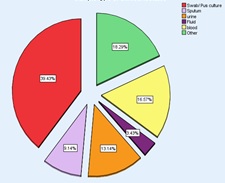Antimicrobial Susceptibility Patterns of Pseudomonas Aeruginosa Isolates in A Tertiary Care Hospital, Peshawar, Pakistan
Abstract
 Abstract Views: 0
Abstract Views: 0
Background. Pseudomonas aeruginosa is an opportunistic pathogen that takes advantage of the host’s weakened system and causes many life-threatening, persistent infections including cystic fibrosis and other lung infections that account for high mortality rates. The presence of several resistant genes (multiple MDR efflux pumps, beta-lactamases) in the genome of P. aeruginosa makes it resistant to many available antibiotics, thus making the currently used treatment options ineffective.
Method. The current study was cross-sectional and focused on examining patients with reported Pseudomonas infections and the analysis of their antibiotic susceptibility profile. Convenient random sampling technique was used.
Results. A total of 101 male and 74 female patients were analyzed and admitted at Rehman Medical Institute. Among them, patients in the age group 41-60 years were the most affected. Antibiotic sensitivity testing reported colistin sulphate as a highly sensitive drug since all the isolates were sensitive to it, followed by imipenem and amikacin.
Conclusion. It was concluded that the most effective antibiotics reported against pseudomonal infections were colistin sulphate and imipenem, whereas aminoglycosides yielded variable outcomes.
Downloads

Copyright (c) 2024 Muhammad Umair

This work is licensed under a Creative Commons Attribution 4.0 International License.
BSR follows an open-access publishing policy and full text of all published articles is available free, immediately upon publication of an issue. The journal’s contents are published and distributed under the terms of the Creative Commons Attribution 4.0 International (CC-BY 4.0) license. Thus, the work submitted to the journal implies that it is original, unpublished work of the authors (neither published previously nor accepted/under consideration for publication elsewhere). On acceptance of a manuscript for publication, a corresponding author on the behalf of all co-authors of the manuscript will sign and submit a completed the Copyright and Author Consent Form.









